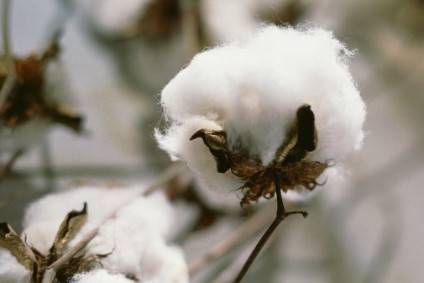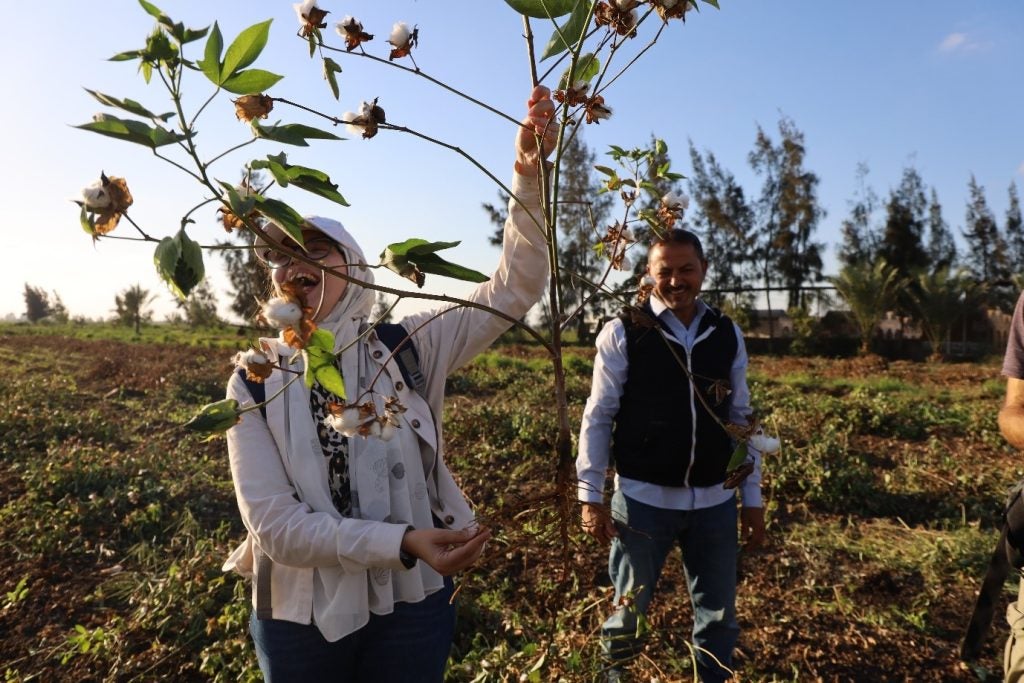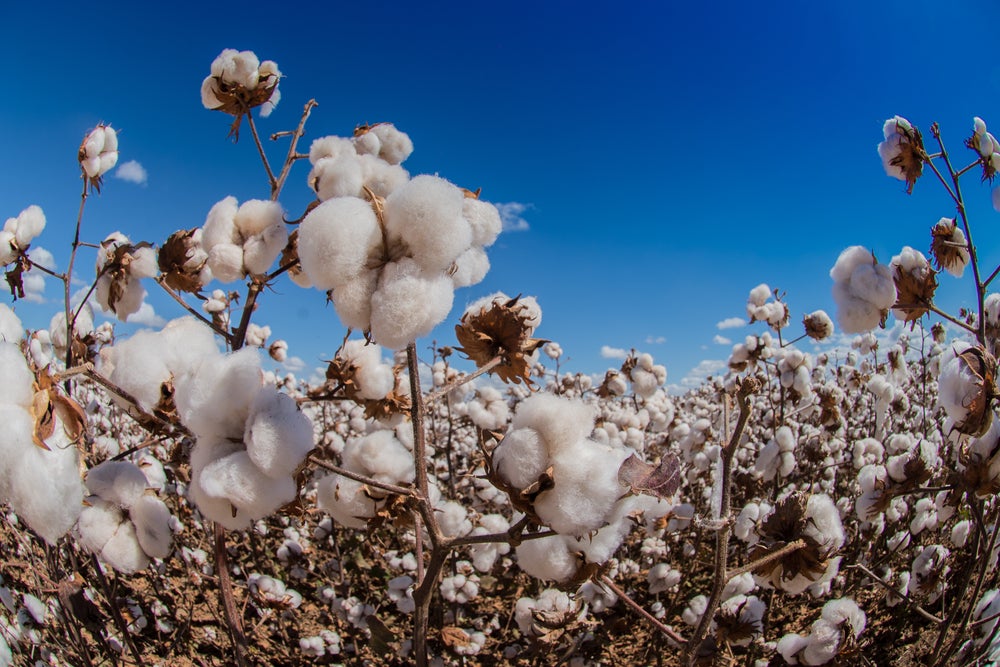
Haiti is making its return to the cotton supply chain with the country’s first cotton harvest in three decades thanks to help from US outdoor apparel and footwear giant Timberland – which also says it hopes to launch products made with the fibre in the next two years.
Once the country’s fourth largest agricultural export, natural disaster, politics and economic instability led to the collapse of Haiti’s cotton industry around 30 years ago.
Timberland, which has worked for the past eight years on a project to plant millions of trees in the country, also saw the opportunity to help return cotton to Haiti in partnership with the Smallholder Farmers Alliance (SFA). Trials began in August last year, when the first cotton seeds were planted – and the first harvest took place last month.
“If successful, this will not only result in the planting of millions more trees in Haiti, and a robust new export opportunity for Haiti…it will also afford Timberland the opportunity to evolve from an SFA donor to an SFA customer,” Colleen Vien, sustainability director for Timberland, tells just-style.
As well as helping to fund the five-year initiative, Timberland has committed to purchase up to one-third of its annual global cotton supply from the Haitian smallholder farmers, subject to price, quality and volume.
See Also:
While still in field trial mode, Vien says there will be several crops harvested and tested over the next few seasons, and it hopes to launch product with the SFA cotton in 2020. Timberland won’t purchase the cotton directly, but will do so indirectly through its partner fabric mills.
How well do you really know your competitors?
Access the most comprehensive Company Profiles on the market, powered by GlobalData. Save hours of research. Gain competitive edge.

Thank you!
Your download email will arrive shortly
Not ready to buy yet? Download a free sample
We are confident about the unique quality of our Company Profiles. However, we want you to make the most beneficial decision for your business, so we offer a free sample that you can download by submitting the below form
By GlobalData“We’ve intentionally capped our commitment at one-third, to encourage the SFA to secure multiple partners and help ensure they are not overly reliant on any one customer. Part of the value we’re bringing to the table for SFA is helping to broker some of these connections, like we’ve done with our sister brand Vans,” Vien explains.
In terms of products, T-shirts, canvas shoes and canvas bags are planned initially. But over time the Haitian cotton could expand into additional categories such as jeans and outerwear.
However Vien is aware of the hurdles that may have to be navigated in order to ensure the project is a complete success.
“One of our biggest challenges early on – and one we’ll continue to address – is ensuring there are markets for the crops being planted in Haiti. Are the right export models in place? Can we make these connections to ensure there are customers on the other end of the supply chain? One big area of focus for Timberland is helping to raise awareness and identify other possible customers for the SFA.”
Delivering impact
Aside from its work on cotton, Timberland has been working with responsible fibre and fabric producer Thread International, which recycles plastic bottles from the streets and canals of Haiti to make its ‘Ground to Good’ performance fabric.
The partnership has led to the launch of the Timberland X Thread sustainable collection of footwear, bags and tees, and “delivers impact beyond environmental value; it also creates social value in the form of much-needed jobs and cleaner neighbourhoods in Haiti,” says Vien. Just last week the company launched a new men’s TBL x Thread footwear collection for spring 2018.
With Timberland’s initial purchase of 76,528 yards of Thread fabric for the collection (rather than 100% conventional cotton), 765,280 plastic bottles were recycled, and 30,521,203 gallons of water and 15,305 pounds of pesticide were saved.
The company’s partnership with Thread also builds on the work it has already done to use recycled plastic bottles in its footwear and apparel. Since 2009, Vien says Timberland has given the equivalent of 310m plastic water bottles new life in footwear.
“The exciting and unique value of the Thread fabric is that it has both an environmental and a social impact associated with our use of the material. This social impact resonated with our consumers and we are working to grow similar partnerships for upcoming seasons.”
Tackling headwinds
The challenges faced by Timberland in ensuring it sources sustainably and ethically stretch beyond Haiti. For the brand and its parent VF Corporation, efforts are underway to simplify supply chain complexities and prioritise long-term working relationships with suppliers.
In particular, VF is moving from transactional exchanges with its supplier factories to partnerships, and recently launched a new global sustainability and responsibility strategy that defined more focused actions to be embedded throughout all aspects of the business.
In a letter to suppliers and sourcing managers, Sean Cady, head of global responsible sourcing for VF, said the company will use its sustainability platform as a way to fuel innovation and growth, not to just reduce its environmental and social footprint.
“At VF, we believe business success and social responsibility are interconnected. The more success we achieve in our business, the more “good” we can do for the world. One of the ways this strategy is being brought to life in the supply chain is to connect future business allocation directly to supplier CSR performance status – with the intent to reward those that are already doing good and further incent others to do the same,” he wrote.
A further challenge is that of transparency – back to the farm level – for key raw material inputs such as cotton, leather hides, and natural rubber.
“There is very little track and trace in the industry for commodities sold via agents and brokers,” Vien says. “This and the cost of sustainable materials is always a challenge, in footwear/apparel and frankly, in most industries. However, as sustainable materials become more readily available, and as consumer demand continues to rise, we can hope to see this shift over time.”
Yet for footwear, it can often be difficult to find sustainable solutions for all of the many components that make up a shoe or boot.
“It can be tough to meet the requirements of bonding and abrasion with various alternative materials – particularly in areas of specific functionality, like in our industrial Timberland PRO products.”
That said, “investments in cross-industry collaborations addressing mutual areas of impact – such as the tyre industry, meat industry, and airline industry – are helping to spark new thinking and will ultimately drive greater scale advancements. Investments in circularity and circular business models are also becoming more prominent.”
Achieving circularity
But to create a truly sustainable fashion industry from end-to-end requires the status quo on how footwear is designed, manufactured, and recovered at end of life to be challenged.
“That’s basically the whole business cycle, and it will take time to shift an entire industry,” Vien says. “In the meantime, there are steps that can be taken to begin moving in that direction – designing footwear with the fewest possible components and simplifying material choices is a good place to start. The less that goes into production, the less waste is created during production and at end of life.
“Increased consumer demand for sustainable materials and responsible supply chains is also needed. At Timberland, our experience is that consumers are interested in footwear that is made responsibly. And again, this comes down to the materials themselves, as well as how the products are made. But for the entire industry to shift, it will take increased consumer demand across market segments broadly.”
For now, Vien says Timberland will continue to build upon the sustainability initiatives it already has in place. This includes steadily increasing the use of renewable, organic and recycled materials across all of its product collections; the work it is doing to help bring cotton farming back to Haiti; and its commitment to community service globally.







